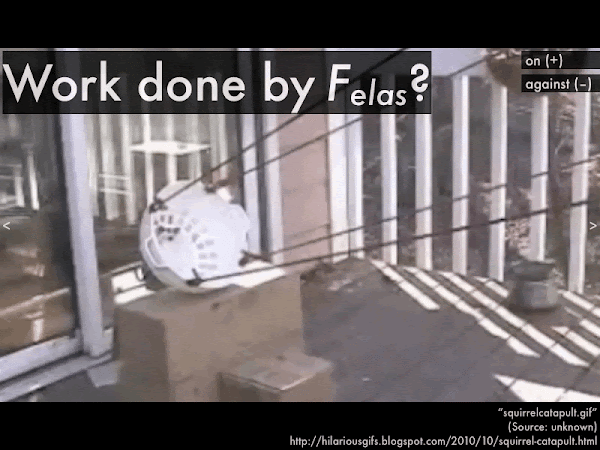Cuesta College, San Luis Obispo, CA
Students have a weekly online reading assignment (hosted by SurveyMonkey.com), where they answer questions based on reading their textbook, material covered in previous lectures, opinion questions, and/or asking (anonymous) questions or making (anonymous) comments. Full credit is given for completing the online reading assignment before next week's lecture, regardless if whether their answers are correct/incorrect. Selected results/questions/comments are addressed by the instructor at the start of the following lecture.
The following questions were asked on reading textbook chapters and previewing a presentation on work and energy.

Selected/edited responses are given below.
Describe what you understand from the assigned textbook reading or presentation preview. Your description (2-3 sentences) should specifically demonstrate your level of understanding.
"The faster an object moves, the more translational kinetic energy it will have. That was a pretty straightforward idea. It also made sense that when an object is stationary it has no translational kinetic energy."
"For something to do work on an object, that something would have to put that object in motion. Even though something is exerting force on an object, it is not classified as work unless there is an energy transfer onto the object."
"Translational kinetic energy is the energy of motion and it depends on mass and speed of an object. Work causes changes in this kinetic energy."
"Forces can do work in order to do work on or against an object. If the work is done on an object, then that means that the work is increasing the objects motion in the same direction. If the work is doing work against an object, then that means the work is decreasing the object's motion in the opposite direction."
Describe what you found confusing from the assigned textbook reading or presentation preview. Your description (2-3 sentences) should specifically identify the concept(s) that you do not understand.
"I could use some explanation on the equation for work."
"I was a little confused about the relationship between work and translational kinetic energy. I don't understand why if the work is negative that the change in kinetic energy also has to be negative and vice versa."
"I don't quite understand the angles associated with zero work."
"The work-energy theorem--the relationships between kinetic energy and work are still cloudy in my mind.
Explain how the SI (Système International) unit for work is related to the SI unit for force.
"They both use newtons."
"They both can be expressed in joules."
"Work has the newton-meter unit, which is newtons times meters. Force has units of just newtons. Work is force, but takes into account displacement."
"Work uses joules, which is force multiplied by displacement."
Match the description of the work exerted by these forces for each object. (Only correct responses shown.)
Pushing in the same direction of motion: work done "on" the object (positive work). [80%]
Pushing opposite the direction of motion: work done "against" the object (negative work). [87%]
Pushing 90° sideways to the direction of motion: no work done. [58%]
Pulling such that the angle between the force and motion is an acute angle (between 0° and 90°): work done "on" the object (positive work). [63%]
Pulling such that the angle between the force and motion is an obtuse angle (between 90° and 180°): work done "against" the object (negative work). [63%]

on; increases. ******************************************* [43] against; decreases. ********* [9] (Unsure/lost/guessing/help!) ******** [8]

on; increases. **** [4] against; decreases. ************************************************** [50] (Unsure/lost/guessing/help!) ****** [6]

on; on. * [1] on; against. **************************************** [40] against; on. ****** [6] against; against. **** [4] (Unsure/lost/guessing/help!) ********* [9]
For Mrs. P-dog's translational kinetic energy to be increased while being catapulted, the amount of work from the bungee cords must be __________ the amount of work from the weight force.
less than. * [1] the same as. ***** [5] greater than. ********************************************* [45] (Not enough information is given.) [0] (Unsure/lost/guessing/help!) ********* [9]
Ask the instructor an anonymous question, or make a comment. Selected questions/comments may be discussed in class.
"Did that catapulted squirrel die? (I do not know the answer to that question. Sounds like some experimental data needs to be collected.)
"Why are we more concerned with the change in Ktr than how much Ktr an object has? (Ask the squirrel. Life is not really about how much translational kinetic energy you happen to have, it only gets interesting when your translational kinetic energy changes...suddenly.)
"I don't know what to put here." (You just did.)
"Is there a situation when work against goes against the direction of motion? Could we go over the angles of the work?" (Yes, and yes.)
"It seems like the work should always be positive; it seems like if the work amount is negative then it is essentially a waste of energy." (Exactly. But sometimes you have to slow down your car with your brakes.)
No comments:
Post a Comment